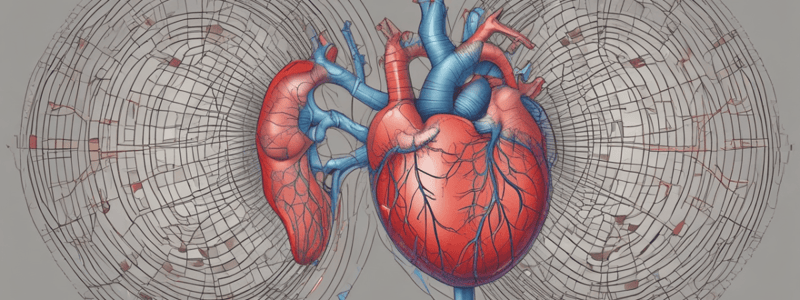Podcast
Questions and Answers
What is the primary function of diastole in the cardiac cycle?
What is the primary function of diastole in the cardiac cycle?
- To contract the heart muscle and push blood into the circulatory system
- To depolarize the atrial and ventricular muscle fibers
- To relax the heart chambers and allow blood to flow into them (correct)
- To increase the pressure in the atria and ventricles
What triggers the atrial contraction during the cardiac cycle?
What triggers the atrial contraction during the cardiac cycle?
- Atrial depolarization (correct)
- Ventricular depolarization
- Isovolumic contraction
- Isovolumic relaxation
What occurs during ventricular contraction in the cardiac cycle?
What occurs during ventricular contraction in the cardiac cycle?
- The atrial muscle fibers contract and squeeze blood into the ventricles
- The heart chambers relax and fill with blood
- The heart muscle contracts, pushing blood into the circulatory system (correct)
- The pressure in the atria and ventricles decreases
During which phase of the cardiac cycle does the atrial contraction occur?
During which phase of the cardiac cycle does the atrial contraction occur?
What is the result of the atrial contraction during the cardiac cycle?
What is the result of the atrial contraction during the cardiac cycle?
What is the cardiac cycle divided into?
What is the cardiac cycle divided into?
What is the primary function of isovolumic contraction in the cardiac cycle?
What is the primary function of isovolumic contraction in the cardiac cycle?
What occurs during isovolumic relaxation in the cardiac cycle?
What occurs during isovolumic relaxation in the cardiac cycle?
What is the result of the coordinated contraction of the ventricles' muscle fibers?
What is the result of the coordinated contraction of the ventricles' muscle fibers?
What is the purpose of the atrial contraction in the cardiac cycle?
What is the purpose of the atrial contraction in the cardiac cycle?
What percentage of the cardiac cycle does isovolumic contraction typically last for?
What percentage of the cardiac cycle does isovolumic contraction typically last for?
What is the result of the pressure gradient during isovolumic relaxation?
What is the result of the pressure gradient during isovolumic relaxation?
Flashcards are hidden until you start studying
Study Notes
The Cardiac Cycle: Understanding Diastole, Atrial Contraction, Ventricular Contraction, Isovolumic Contraction, and Isovolumic Relaxation
The cardiac cycle refers to the continuous mechanical and electrical events that occur in the heart during each heartbeat. It consists of a series of states that coordinate the movement of blood through the heart and the circulatory system. The cardiac cycle can be divided into diastole and systole, with each phase involving different processes.
Diastole
Diastole is the period when the heart chambers are relaxed and the blood flows into them. During this phase, the atria and ventricles fill with blood from the veins and arteries, respectively. The pressure in both chambers is lower than the surrounding blood vessels, allowing blood to flow into the heart.
Atrial Contraction
Atrial contraction, also known as atrial systole, occurs during diastole. This process is triggered by the atrial depolarization and results in a coordinated contraction of the atrial muscle fibers. The atria squeeze, increasing the pressure within the chambers, and blood is forced into the ventricles.
Ventricular Contraction
Ventricular contraction, also known as ventricular systole, is the period when the heart muscle contracts, pushing blood into the circulatory system. It begins after the atrial contraction and is triggered by the ventricular depolarization. The ventricles contract due to the coordinated contraction of their muscle fibers, increasing the pressure within the chambers. This pressure gradient forces blood into the pulmonary trunk (from the right ventricle) and the aorta (from the left ventricle).
Isovolumic Contraction
Isovolumic contraction is the initial phase of ventricular contraction when the tension and pressure in the ventricle increase, but no blood is pumped or ejected from the heart. This phase ensures that the ventricles generate enough pressure to overcome the resistance in the semilunar valves and the surrounding blood vessels. It typically lasts for 6% of the cardiac cycle.
Isovolumic Relaxation
Isovolumic relaxation is the initial phase of ventricular diastole when the pressure in the ventricles drops below the pressure in the two major arteries, the pulmonary trunk, and the aorta. This pressure gradient causes blood to attempt to flow back into the ventricles, resulting in the dicrotic notch of the ECG and closing the two semilunar valves. It typically lasts for 8% of the cardiac cycle.
In summary, the cardiac cycle is a complex series of events that regulate the flow of blood within the heart and the body. The coordinated contraction and relaxation of the atria and ventricles ensure that blood is efficiently pumped and circulated throughout the body.
Studying That Suits You
Use AI to generate personalized quizzes and flashcards to suit your learning preferences.




